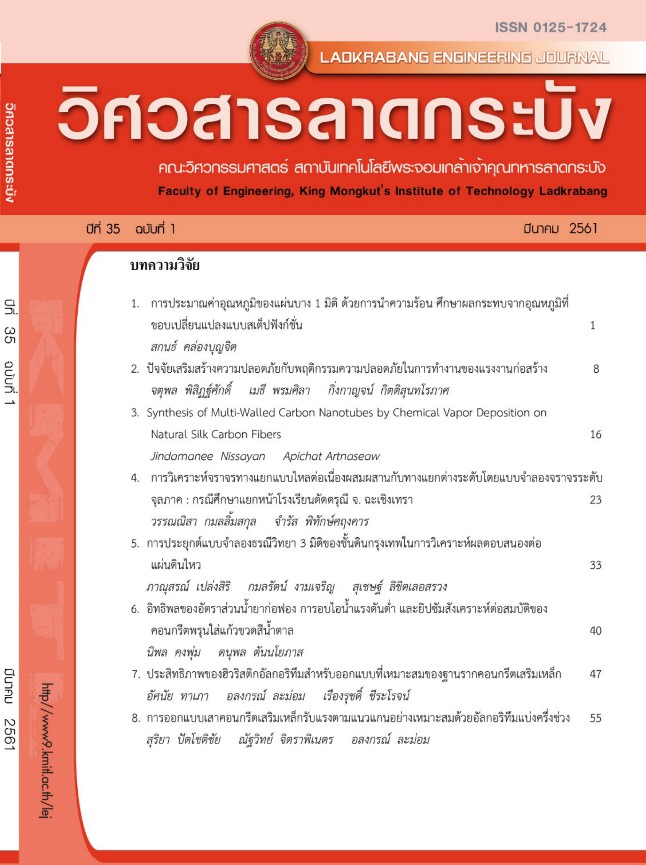การประยุกต์แบบจำลองธรณีวิทยา 3 มิติของชั้นดินกรุงเทพในการวิเคราะห์ผลตอบสนองต่อแผ่นดินไหว
คำสำคัญ:
แบบจำลองธรณีวิทยา 3 มิติ, แผ่นดินไหวทาร์เลย์, การวิเคราะห์ผลตอบสนองของชั้นดินต่อแผ่นดินไหวแบบ ไม่เชิงเส้น, ชั้นดินกรุงเทพบทคัดย่อ
บทความนี้นำเสนอผลการวิเคราะห์แผ่นดินไหวของชั้นดินกรุงเทพโดยอาศัยแบบจำลองธรณีวิทยา 3 มิติ ในการเลือกชั้นดิน สมมติฐานความหนาของชั้นดินอ่อนส่งผลต่อการวิเคราะห์ผลตอบสนองต่อแผ่นดินไหวถูกนำมาใช้ในงานวิจัย การศึกษานี้ได้ใช้การวิเคราะห์ผลตอบสนองต่อแผ่นดินไหวด้วยวิธีวิเคราะห์แบบไม่เชิงเส้นหนึ่งมิติโดยใช้คลื่นแผ่นดินไหวที่เคยเกิดขึ้นจริงในประเทศไทย สมการความสัมพันธ์ของความเร็วคลื่นเฉือนกับกำลังรับแรงเฉือนและจำนวนครั้งการตอกมาตรฐานถูกนำมาใช้ในในแบบจำลอง ผลการศึกษาแสดงค่าความเร่งสูงสุดที่ผิวดินและผลตอบสนองเชิงสเปคตรัมที่ได้จากการวิเคราะห์โดยใช้คลื่นแผ่นดินไหวทาร์เลย์ งานวิจัยฉบับนี้พบว่าผลของชั้นดินอ่อนในพื้นที่กรุงเทพนั้นส่งผลต่ออัตราคูณขยายกำลังของคลื่นแผ่นดินไหว เมื่อความหนาของชั้นดินอ่อนสูงขึ้นอัตราการขยายกำลังของคลื่นสั่นไหวมีค่ามากขึ้นด้วยเช่นกัน
References
D. M. Boore, “Estimating Vs(30) (or NEHRP sire classes) from shallow velocity models (depths < 30 m)”, Bulletin of the seismological society of America, Vol. 94(2), pp. 591-597, 2004.
Department of Public Works and Town & Country Planning, “Earthquake Resistance Building Design Standards (DPT standard 1302-52)”, 2009.
H. B. Seed., and I. M. Idriss, “Soil moduli and damping factors for dynamic response analyses”, Retrieved from California, 1970.
H. B. Seed., M. Romo., J. Sun., A. Jaime., and J. Lysmer, “The mexico earthquake of September 19, 1985 – Relationships between soil conditions and earthquake ground motions”, Earthquake Spectra, Vol. 4(4), pp. 687-729, 1988.
K. Ngarmcharoen, “Geotechnical engineering database of Bangkok subsoils for pile foundation design”, Master’s Thesis, Department of Civil Engineering, Faculty of Engineering, Chulalongkorn, 2015.
K. Ngarmcharoen., S. Likitlersuang., and T. Boonyatee, “Development of 3D Geological Modelling for Bangkok Subsoils”, The Twenty-Ninth KKHTCNN Symposium on Civil Engineering, 2016.
M. Vucetic., and R. Dobry, “Effect of soil plasticity on cyclic response” Journal of geotechneical engineering, Vol. 117(1), 1991.
N. Abrahamson., and W. Silva, “Summary of the Abrahamson & Silva NGA ground-motion relations”, Earthquake Spectra, Vol. 24(1), pp. 67-97, 2008.
P. Warnitchai, “Development of seismic design requirements for buildings in Bangkok against the effects of distant large earthquakes”, The 13th world conference on earthquake engineering, Vancouver, 2004.
S. Likitlersuang., and K. Kyaw, “A study of shear wave velocity correlations of Bangkok subsoil”, Obras y Proyectos:Revista de Ingenieria, Vol. 155(7), pp. 27-33, 2010.
[S. Likitlersuang., S. Teachavorasinsakun., C. Surarak., E. Oh., and A.S. Balasubramaniam, “Small Strain Stiffness and Stiffness Degradation Curve of Bangkok Clays”, Soils and Foundations, Vol. 53, No. 4, pp. 498 – 509, 2013.
S. Soralump., B. Kunsuwan., W. Mairaing., and A. Surinkum, “Development of soil database for supporting the development and maintenance of infrastructure : A case study of soft Bangkok clay”, CIVIL ENGINEERING MAGAZINE, pp. 47-69, 2010.
T. Imai, “Correlation of Nvalue with S-wave velocity and shear modulus”, The second European symposium on penetration testing, 1981.
Y. Choi, and J. P. Stewart, “Nonlinear site amplification as function of 30 m shear wave velocity”, Earthquake Spectra, Vol. 21(1), pp. 1-30, 2005.
Y. M. A. Hashash., M. I. Musgrove., J. A. Harmon., D. R. Groholski., C. A. Phillips., and D. Park, “DEEPSOIL 6.1, User Manual”, Board of Trustees of University of Illinois at Urbana-Champaign, Urbana, 2016.
Downloads
เผยแพร่แล้ว
How to Cite
ฉบับ
บท
License
บทความที่ได้รับการตีพิมพ์เป็นลิขสิทธิ์ของคณะวิศวกรรมศาสตร์ สถาบันเทคโนโลยีพระจอมเกล้าเจ้าคุณทหารลาดกระบัง
ข้อความที่ปรากฏในบทความแต่ละเรื่องในวารสารวิชาการเล่มนี้เป็นความคิดเห็นส่วนตัวของผู้เขียนแต่ละท่านไม่เกี่ยวข้องกับสถาบันเทคโนโลยีพระจอมเกล้าเจ้าคุณทหารลาดกระบัง และคณาจารย์ท่านอื่นๆในสถาบันฯ แต่อย่างใด ความรับผิดชอบองค์ประกอบทั้งหมดของบทความแต่ละเรื่องเป็นของผู้เขียนแต่ละท่าน หากมีความผิดพลาดใดๆ ผู้เขียนแต่ละท่านจะรับผิดชอบบทความของตนเองแต่ผู้เดียว






